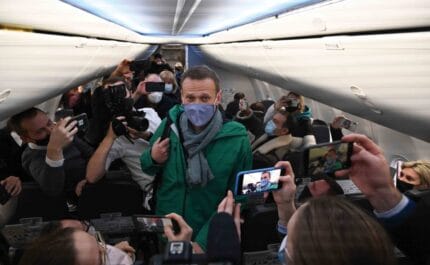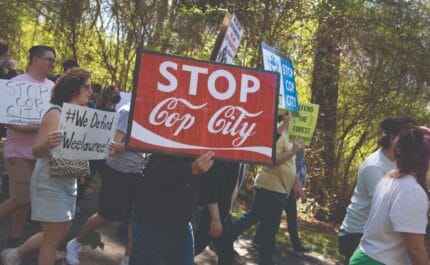The age of the ultras
From November 2013 to February 2014 in Ukraine, groups of violent football fans banded together in the Euromaidan uprising to help depose the country’s pro-Russian president. Five years on from the drama of the Ukrainian revolution, the firms found they had been brought in from the fringes of society and, as James Montague reported in DG #34, were determined to gain political power in an anxious and unstable country

Supporters of the Ukrainian far-right party National Corps gesture during their rally in Kyiv’s Independence Square, 23rd March 2019. Photo: Sergei Supinsky / AFP / Getty Images
20th Feb 2019 (Taken from: #34)
February 2019
Outside the main municipal building in the Ukrainian capital of Kyiv, just a few minutes’ walk from Independence Square, Serhii Filimonov and a dozen of his friends and colleagues are unfurling a banner. It’s a cold winter morning. Grey clumps of snow are piled up on the pavement and the rain is falling harder with each passing minute. Filimonov and his group are here to picket the municipality over a potential real-estate agreement that would hand a large chunk of public land to a local oligarch in what they say is a corrupt deal. They plan to reconvene a few hours later at a historical monument in the city to protest the recent killing of a female activist, Kateryna Handziuk.
Handziuk, an advisor to the mayor of Kherson, a city in the south of Ukraine, had become known for exposing local corruption. Her regular Facebook posts didn’t discriminate: police officers, government officials and well-known businessmen were all exposed for their alleged wrongdoing. On 31st July 2018, Handziuk was approached by a man who poured a litre of sulphuric acid over her. She received burns covering a third of her body and underwent 11 operations. She died of her injuries five months later. She was 33 years old.
No one has yet been jailed for her killing.
“We don’t like the events surrounding the investigation into Handziuk,” says Filimonov, a well-built man in his mid twenties dressed in the expensive sportswear associated with the ‘football casual’ subculture. The young men who have joined him are dressed much the same, many with tattoos just about visible as they snake up over their throats or poke out beneath their jacket sleeves. Filimonov’s left arm is protected in a brace, his hand bandaged. He says he will keep campaigning until Ukraine’s president, Petro Poroshenko, intervenes to ensure that those guilty of Handziuk’s murder are brought to justice.
This is how Filimonov fills his days, in a carousel of direct action against what he views as the corrupt elite who have operated with impunity for decades and are protected by a captive judiciary. But Filimonov isn’t a liberal activist. He is a football ultra, part of a network of organised, hardcore fans known for their colourful choreographies and pyrotechnic displays in the stands. He is the leader of Dynamo Kyiv’s most notorious “firm” (an active hooligan faction within an ultras group), the “Rodychi” (The Relatives), notorious for organising fights with other football supporters, often held in forests and fields far from the prying eyes of the police.
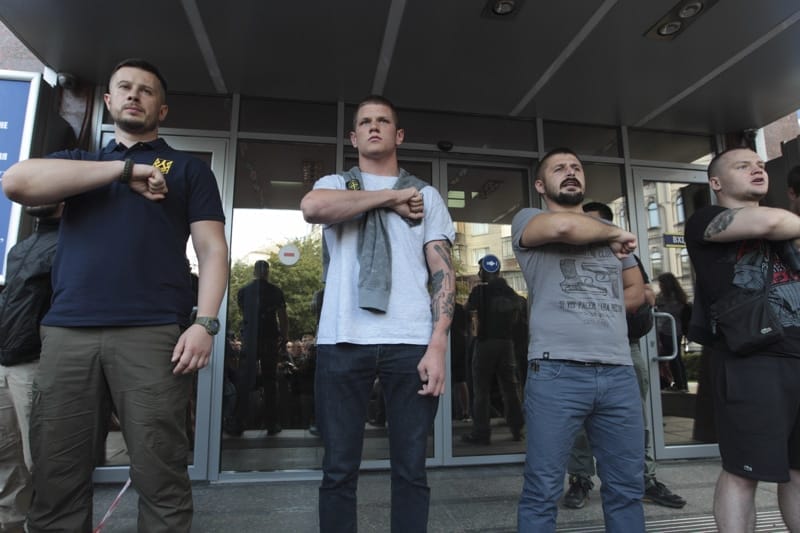
Serhii Filimonov (second from left) stands alongside Andriy Biletsky (left) and other ultras after being released on bail from a district court in Kyiv on 10th September 2016. Photo: Zuma Press, Inc / Alamy Live News
Filimonov is also head of the Kyiv division of the National Corps, a political party that is part of an ongoing normalisation of the far right in Ukrainian politics. The National Corps and similar groups are using new tactics that make them hard to pin down, cutting across national barriers and ideological lines as they protest against Petro Poroshenko, their biggest enemy after Vladimir Putin. Poroshenko, an oligarch who made his fortune from chocolate, was elected as the country’s first president after the Euromaidan uprising which deposed Viktor Yanukovych. He has overseen a disastrous war in the east while the economy has flatlined. His popularity is in the basement and he is lying third in the polls ahead of the presidential elections, due to start in a month.
Such is Ukraine’s disillusionment with politics that an actor is leading the polls: Volodymyr Zelensky, a man with zero political experience and an unclear agenda. In the Ukrainian series Servant of the People, Zelensky played Vasyl, a teacher who accidentally became president after a secretly recorded video of him railing against corruption went viral. For Ukrainians jaded by years of corruption and war, Ukraine’s answer to Martin Sheen (who played the US president Jed Bartlet in The West Wing) seemed as good a bet as anyone. Filimonov has been busy organising protests at Poroshenko’s campaign rallies, but today he has more immediate concerns. He nods towards a nearby police officer who is listening to our conversation. “This is the head of local police; he is listening to us,” he says. “We are being watched by spies.”
The remains of the day
Today is the fifth anniversary of the bloodiest day of the Euromaidan uprising, but Maidan Nezalezhnosti, or Independence Square, is almost empty.
The revolution began in late 2013 when hundreds of thousands of Ukrainians took to the streets to protest against Viktor Yanukovych. The then-president had promised to sign an association agreement with the EU, a signal to the country’s young population that Ukraine was seeking a future with closer ties to the west. But Russia opposed the move, as President Putin feared that another key trading partner and strategic asset could be lost to his EU rivals. Yanukovych pulled out of signing the documents under intense pressure from Moscow and major protests erupted across Ukraine in the weeks that followed, with the biggest taking place in Independence Square.
On 18th February 2014 the stand-off escalated as snipers began killing protesters in Kyiv. Over the next three days, 100 people were killed, the majority on 20th February, the bloodiest day of the revolution. The dead have since been named the “heavenly hundred”. A makeshift memorial snakes up one path next to Independence Square, a long line of temporary shrines each featuring a photo of one of the killed protesters: on the anniversary this year, 100 beams of light were projected into the sky to commemorate them. On 22nd February 2014 Yanukovych fled the capital, headed to his native eastern Ukraine and crossed the border into Russia, where he sought refuge.
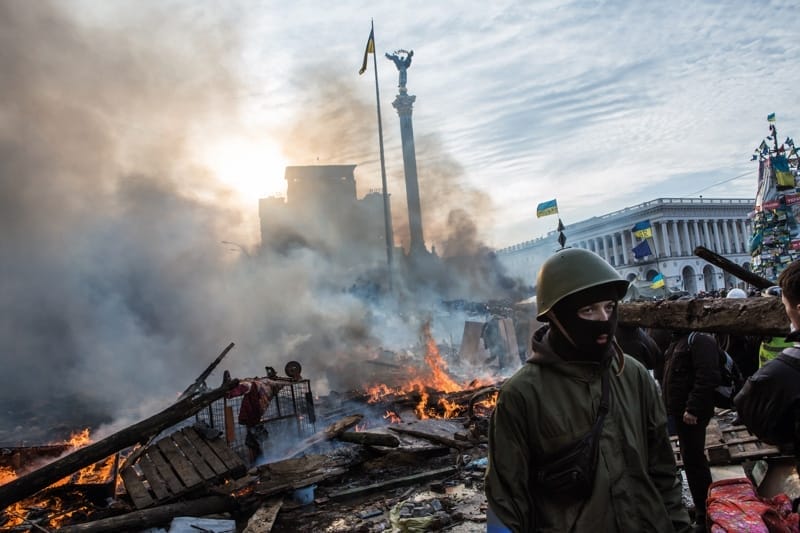
An anti-government protester standing next to burning rubble in Kyiv’s Independence Square on 19th February 2014, one of the deadliest days of the Euromaidan revolt. Photo: Brendan Hoffman / Getty Images
The protesters’ victory was won with the help of large numbers of organised football supporters – the ultras – who joined with activists in the square. Almost all were from far-right ultra groups steeped in a culture of violence and which regularly clashed with one another inside and outside football grounds.
The ultras converged on Maidan and buried their enmity. Former hated rivals joined the same side and, crucially, brought with them the experience of fighting with the police. They gained the respect of even the most liberal protesters for being the muscle of the revolution. They were idolised by far-right politicians. “Let us applaud the heroic soccer fans of Dnipro Cherkasy, Kapaty Lviv and Vorskla Poltova!” said Oleh Tyahnybok, the leader of the nationalist, far-right Svoboda party at the time. “This is where solidarity starts. This is where patriotism starts.”
When Russia annexed Crimea in retaliation for the overthrow of president Yanukovych and fuelled a war in the east by backing pro-Russian separatists, thousands of ordinary Ukrainians volunteered to help their country’s woefully underprepared and underfunded military. One battalion of volunteers, Azov, was commanded by a former political prisoner under Yanukovych, Andriy Biletsky. Biletsky had founded the National Socialist Assembly, a coalition of extreme nationalist, radical right and neo-Nazi groups. His aim, according to a 2014 manifesto, was to “lead the white races of the world in a final crusade… against Semite-led Untermenschen”. (He has since denied that he ever espoused antisemitic views).
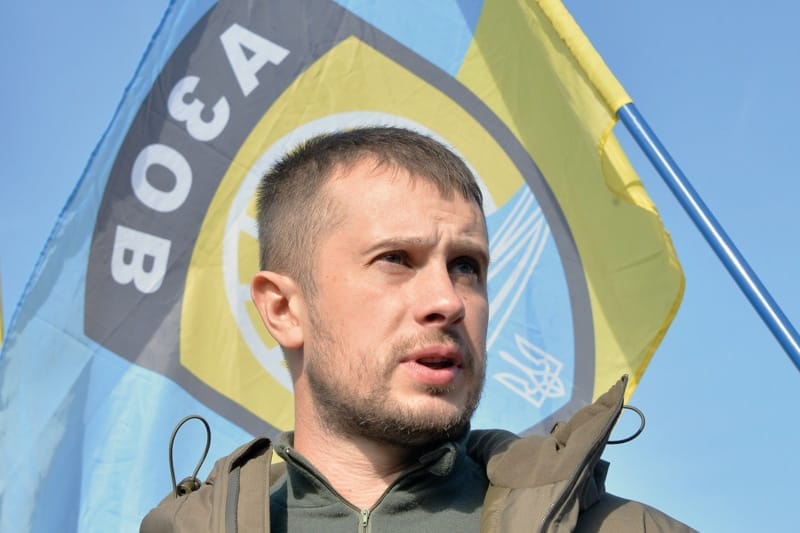
Azov commander Andriy Biletsky at an oath ceremony for his battalion members in Kyiv, 19th October 2014. Photo: Genya Savilov / AFP / Getty Images
The bulk of Azov soldiers were drawn from members of Ukraine’s ultra groups: Filimonov was one of the first to sign up. They proved to be a fearsome unit and famously retook the strategically vital port city of Mariupol from Russian-backed forces in June 2014. A film, The Ultras, was made and shown on prime-time TV showing how the ultras had triumphed at Mariupol and made a courageous stand at Donetsk’s shattered airport.
In 2016 Andriy Biletsky was chosen to be the leader of Azov’s new political wing, the National Corps, and Filimonov was chosen as the head organiser for Kyiv. As quiet as Maidan is on the fifth anniversary of a day freighted with national memories, gazebos have been set up for some of the candidates for the upcoming presidential election. Although it isn’t fielding a candidate, the National Corps has its own tent with young men and women handing out leaflets with two pictures on them – of Biletsky and, underneath, of Filimonov.
From hooligan to veteran
Filimonov’s office has a brand new reinforced steel door with an electronic security keypad. In the corner is a cabinet designed to house shotguns and ammunition. When I arrive, I find Filimonov sitting behind his large wooden desk examining his injured left arm. “They were beating us so hard,” he says. The week before, on Valentine’s Day, Filimonov had travelled to Athens to watch his team, Dynamo Kyiv, play Olympiakos in a Europa League match but had a run-in with Greece’s notoriously baton-happy police. “I almost lost my consciousness,” he says of the violence he encountered. “I have never been beaten so hard before. My finger could even be amputated.”
We are talking in the new HQ of Filimonov’s apparently thriving security business, which he runs in-between organising and training for football fights and leading the National Corps’ Kyiv division. As we talk, dozens of men pass through, all veterans from Azov who have now found employment after their tour of duty finished.
I was told I must go first into the building and kill everyone”
Filimonov explains how he got here. As a young kid he was into wrestling. “Whenever you are good at sports you will eventually get a proposal to try yourself in a fight in ‘okolofutbola’,” he says. ‘Okolofutbola’ means “around football” in Russian, and is used to describe the pre-arranged hooligan fights that take place before matches. He enjoyed the fighting and was good at it, quickly rising to head his own group named after Stepan Bandera, a Ukrainian ultra-nationalist leader from World War II with a complicated legacy: nationalists regard him as a hero for trying to establish an independent state; others point to the fact that he collaborated with the Nazis and was responsible for the massacre of Poles and Jews.
When the Euromaidan uprising began, old football rivalries withered. “Just before Maidan I was jumped by 20 anti-fascist fans from Arsenal Kyiv. I was more than angry,” Filimonov recalls. Arsenal Kyiv is the only leading club in Ukraine with left-wing ultras. “When Maidan started, I saw the same guys there! But I said this was not the time [for revenge]. So, I shook their hands. We have these ideological and club differences but we shook hands. Maidan was not left-wing or right-wing, Nazi or commie, or whatever. This was the war against Yanukovych.”
The days leading up to the bloody denouement of the Maidan uprising were chaotic. The ultras, says Filimonov, took to the front lines “to give people at Maidan a feeling of security and understanding that they are being guarded. They won’t fight physically, right? But it gives them the feeling that they have back-up and people willing to give up their lives for this noble cause.”
As the police attempted to take back the square, Filimonov and about 40 of his fellow ultras ended up being pushed back and cornered. They decided to flee to the Canadian embassy as one of their group had a Canadian passport. After easily pushing past the security, they sheltered there for two days. They even considered applying for asylum in Canada where they could train, regroup and return to fight another day.
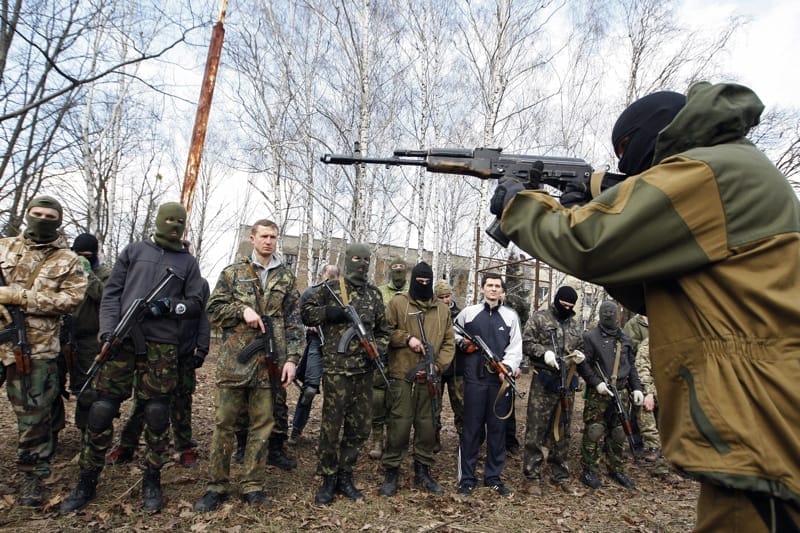
An instructor for the ultra-nationalist volunteer Azov battalion runs training exercises in Kyiv on 1st March 2015. Photo: Yury Kirnichny / AFP / Getty Images
The protesters eventually won the day and after Yanukovych fled east; Filimonov left the embassy and began planning for what he believed was the inevitable war to come. He travelled to Dnipropetrovsk in central Ukraine with a group of like-minded Dynamo fans. There he met with ultras from Dnipro, a team that had a friendship with Dynamo. Around 50 of his group volunteered for Azov. Their first taste of action was in Mariupol.
“During the training I only had five bullets. I had a supermarket security uniform,” Filimonov says. I ask him about the mission he was assigned. “The storming group,” he says. “I was told I must go first into the building and kill everyone.” The liberation of Mariupol in June 2014 made Azov’s name. After a string of humiliating defeats for the Ukrainian army, it proved that the Russian-backed forces (and Russian troops themselves) could be stopped.
Filimonov’s military career would end two months later at post-revolution Ukraine’s military nadir: the Battle of Ilovaisk. As many as 1,000 servicemen were killed when a botched raid on the city was followed by a botched retreat, hampered by malfunctioning equipment, poor planning and bad weather. Filimonov was caught in an ambush by pro-Russian forces. “Our commander said we should try to escape but not everyone will survive,” he says. “We should run and not stop when someone falls, because it will be our death too.” He was badly wounded by a grenade and invalided out of the battalion.
Playing down the right wing
Filimonov doesn’t look or sound like a stereotypical fascist. He is young, articulate, charismatic and handsome. He doesn’t use overtly racist language. Instead he talks about corruption and bringing oligarchs to justice. His Instagram account is a carefully curated mix of football casual fashion, family-man snaps with his wife and young son and topless shots of him working out or training recruits on how to handle a machine gun. Other photos show him in jail or standing trial, something that happens regularly after he undertakes what he calls “civic action”.
As a result of their role in Maidan, and also because of their position as veterans, Filimonov and his ultras have a new, elevated status in Ukraine. Where once they were seen as irrelevant, almost comical characters, they are now feted as revolutionary heroes. “The majority of Ukrainian liberals are in a close relationship with radical nationalists,” says Professor Volodymyr Ishchenko, a sociologist at Kyiv’s Polytechnic Institute. “They legitimate them, they tolerate and justify their violence. This is one of the biggest problems with civil society.”
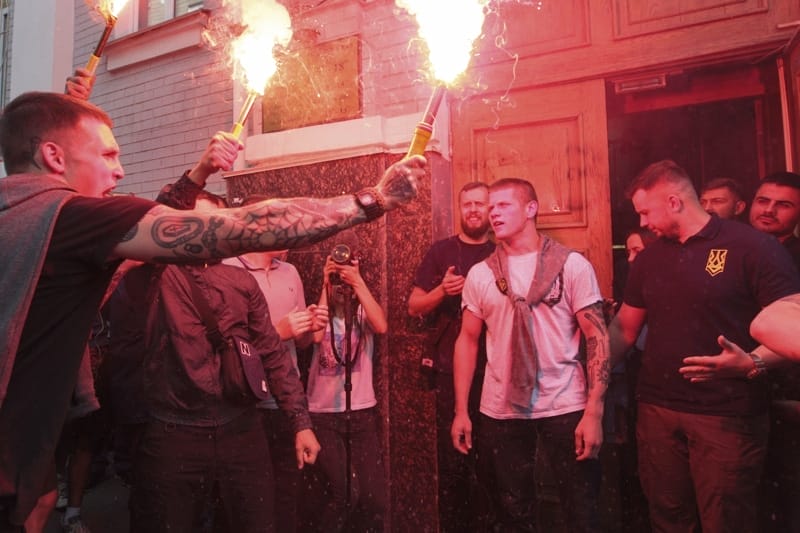
Serhii Filimonov with fellow members of the National Corps in 2016. Photo: Zuma Press, Inc / Alamy Live News
The National Corps burst onto the scene as a new political force in October 2016 when thousands marched through Kyiv in balaclavas and military fatigues carrying flaming torches. They chanted “Death to enemies!” and “Glory to the nation!” as Andriy Biletsky was voted in as party leader on a four-year term. At the same time a new force, the National Militia, emerged as the militant street wing of the party. “When the authorities are impotent and cannot solve issues of vital importance for society, then simple, ordinary people are forced to take responsibility upon themselves,” Biletsky told Ukrainian media when asked why a political party needed its own militia.
The group is thought to be under the patronage of Ukraine’s interior minister, Arsen Avakov, who has long ties to the ultra-nationalist movement. It was Avakov’s decision to incorporate Azov into the regular army’s National Guard. “Although presented as a means to defuse the ultra-nationalist battalion, [this move] led to its explosive growth and branching out into the National Corps political party and increasingly assertive National Militia street movement,” wrote journalist Oleksiy Kuzmenko in an investigation for news website Bellingcat.
Since Euromaidan there has been a roll call of violent events involving emboldened far-right and openly neo-Nazi groups. According to Kuzmenko’s Bellingcat investigation, “the National Corps and National Militia threatened a Ukrainian Roma community near Kyiv and later razed the abandoned campsite, streaming the event on Facebook Live.” There have since been other attacks on Roma camps, as well as on LGBT events and marches celebrating women’s rights. These involved a host of organisations from the same far-right eco-systems: groups such as C14, Right Sector and Tradition and Order. In all cases the police did little to intervene.
Near total impunity is enjoyed by members of groups that promote hatred and discrimination through violent means”
The inaction prompted four prominent human rights groups – Amnesty International, Front Line Defenders, Freedom House and Human Rights Watch – to release a joint open letter to Avakov. “Hiding under a veneer of patriotism and what they describe as ‘traditional values’, members of these groups have been vocal about their contempt for and intent to harm women’s rights activists, ethnic minorities, lesbian, gay, bisexual, transgender and intersex people and others who hold views that differ from their own,” they wrote. “The near total impunity enjoyed by members of groups that promote hatred and discrimination through violent means creates the impression that these attacks are tolerated by the Ukrainian authorities.”
The thousand-year city
The National Corps has denied that it is a neo-Nazi organisation. “If the world is worried about the threat of Ukrainian neo-Nazism, I can assure you we are not neo-Nazis; we are simply people who want to change our country for the better,” Ihor Vdovin, a spokesman for the National Militia told the Guardian in March 2018.
Ukraine’s growing far right has often been highlighted in Russia’s tightly controlled media, which frame Euromaidan not as a people’s uprising, but an illegitimate fascist takeover abetted by a CIA obsessed with fomenting revolution. As a result, Ukrainian authorities have defensively played down accusations that the far right is gaining a foothold in the country, pointing out that, electorally speaking, all far-right groups rarely meet the five percent threshold needed to gain a first MP in parliament. However, the political situation is not as clear-cut as the authorities like to suggest. People do vote for mainstream parties with far-right policies, and the second biggest party at the last parliamentary elections was the People’s Front, which contains several well-known far-right figures, including Avakov, the interior minister who normalised Azov.

National Corps supporters set off flares at an anti-government protest in Kyiv on 2nd March 2019. Photo: Ergei Supinsky / AFP / Getty Images
Filimonov denies that he is a neo-Nazi, even though some of his associates, identified in the Bellingcat investigations, sport Nazi tattoos. To prove that his concern is “corruption, the need to stop stealing” rather than a neo-Nazi agenda, he takes me to a building in Kyiv that, he says, his group is trying to save from development into a hotel by a corrupt local oligarch he believes is working for Russian interests. On one wall is a huge mural of a snake with Putin’s head. He points in the direction of St Sophia’s Cathedral. “It was built 1,000 years ago,” he says. “In Ukraine you had buildings; in Russia only frogs.” Ultimately, he believes, fighting corruption will require gaining political office. “For real changes, you need real power,” he says.
The next day we meet at Kyiv’s Olympic stadium. It is the return match against Olympiakos in the Europa League. The night before, Filimonov’s crew went out looking for Olympiakos fans to exact revenge for the events of a week earlier, but to no avail. It is a freezing night but almost 50,000 people are in the stadium. Filimonov arrives late, carrying his young son. “This is his first game!” he says. He’s accompanied by Rodion Kudryashov, head of Dnipro’s ultras as well as one of the highest-ranked members of the National Corps.
Behind us, in the upper tier of the stadium, a protest begins. Red flares are lit and a banner is unfurled calling for justice for Handziuk, the activist killed by an acid attack in Kherson. The Relatives hooligan faction are relatively small in number, compared to the huge bank of Dynamo ultras on the other side of the stadium. The two sit in separate areas after a falling out between the groups’ leaders. So it is important for Filimonov to be there. “I’m here to show my face and shake the hands of the people who have come,” he says. Fifteen minutes later he is gone. He misses the celebrations at the final whistle as Dynamo win 1-0.
April 2019
In the build-up to the presidential elections it is widely reported that Biletsky is considering a run, but in the end he does not announce his candidacy.
As the campaigns in Ukraine build to a climax, I watch YouTube videos and news reports of demonstrations. The National Corps and its paramilitary wing, the National Militia, protest in large numbers, often disrupting rallies for President Poroshenko. They are fuelled by a new corruption scandal: allegations that a key presidential ally on Poroshenko’s national security council smuggled military parts from Russia and sold them at hugely inflated prices to the Ukrainian army. Thanks to his arm brace I can spot Filimonov at the front of the protests, trying to herd and organise hundreds of men dressed all in black. The disruption of rallies becomes so bad that ambassadors for the G7 issue a public letter to interior minister Avakov calling for him to intervene in the campaign to guarantee free and fair elections.
In an extraordinary case of life imitating art, on 21st April the comedian and political novice Volodomyr Zelensky is elected president in the second round of voting, winning 73 percent of the poll to Poroshenko’s 25 percent. “I will never let you down,” he tells a group of cheering supporters. “Everything is possible.”
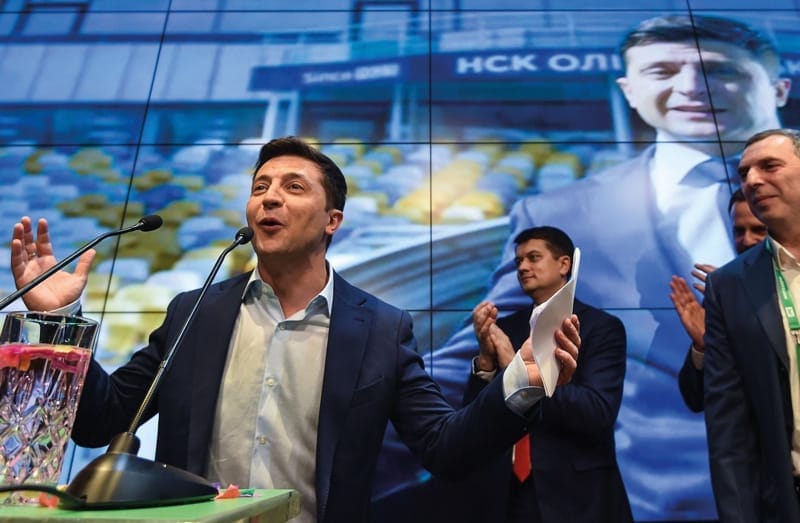
Comedian Volodymyr Zelensky gives a victory speech in Kyiv after winning the second round of the election on 21st April 2019. Photo: Genya Savilov / AFP / Getty Images
“I’m usually pessimistic because the state is very weak in Ukraine and it will get weaker,” says Professor Ishchenko of the country’s prospects under its new leader. “Economic prospects are poor. There are deep cleavages exploited by political parties. This is all looking pretty bad. There is some hope in Zelensky. But whatever good intentions he has, there are very strong structural problems [that are] unlikely to be solved in the near future. Ukraine’s future is more likely to be decided in Moscow, Brussels and Washington than Kyiv.”
In one of his first acts, Zelensky moves the elections for the Ukrainian parliament forward from October to July, likely too soon for the National Corps to make a breakthrough. Party leader Biletsky agrees a pact with the far-right Svoboda and Right Sector parties in the hope of reaching the 5 percent threshold and gaining an electoral upset. When the combined 20-person list is announced, Filimonov is not on it. He quits the party in the days after the announcement, citing a corruption scandal at Azov, and says he will form his own political group, tentatively called ‘Honour’.
The far right dominate the street. They have the strongest street movement in Europe”
The far right faces challenges breaking out of its role on the street and into parliament, says Professor Ishchenko, but that is not the only way to wield power in Ukraine. “They cannot win elections but so what?” he says. “Elections are an important indicator. But only one. It’s like in France, the Rassemblement National [formerly the Front National] scores 20 percent. That is a big problem. But on the other hand, how many battalions do they have? Zero. Here the major far-right groups can’t win a seat in the parliament, but they have militias, veterans, arms, training. Electorally they are weak, but in extra-parliamentary terms they are among the strongest groups in civil society. The far right dominate the street. They have the strongest street movement in Europe.”
Filimonov continues to push his activist agenda. Next on the list is a street campaign to grant citizenship to the foreign fighters from Russia, Belarus, Croatia and beyond who joined Ukraine’s volunteer battalions. In some cases, they have effectively been rendered stateless. “It is vital for them to get Ukrainian citizenship,” he says. “They can’t go home, because they’ll be imprisoned there.” There are also some football fights arranged with other firms across Europe to train for, once his finger has fully healed. A procession of confrontations beckons – against fellow ultras, oligarchs, politicians and the separatists in the east.
He has a surprising confession to make, for an ultra. “I don’t like football,” he admits. “But I like it when we win a tough game.”
Slow Journalism in your inbox, plus infographics, offers and more: sign up for the free DG newsletter. Sign me up
Thanks for signing up.
